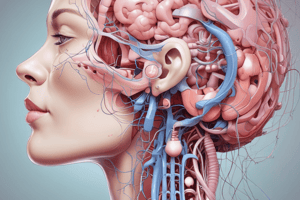Podcast
Questions and Answers
What are the three features that help identify a thyroid gland that is larger than normal?
What are the three features that help identify a thyroid gland that is larger than normal?
Between the large distended follicle lined by flattened cuboidal epithelium, proliferation of follicle, and overall increase in size of the organ with large amount of colloid
What can be seen in the organized edge of the Endometrium in Adenomyosis of the uterus?
What can be seen in the organized edge of the Endometrium in Adenomyosis of the uterus?
Endometrium in the proliferative phase which has endometrial glands containing goblet and secretory cells surrounded by lamina propria
What is abnormal about the myometrium in Adenomyosis of the uterus?
What is abnormal about the myometrium in Adenomyosis of the uterus?
Choristoma formation (endometrial gland & lamina propria are evidence) and Endometriosis
What can be seen in a small area of a breast section that is normal in Fibroadenoma of the female breast?
What can be seen in a small area of a breast section that is normal in Fibroadenoma of the female breast?
What are the four abnormalities seen in Fibroadenoma of the female breast?
What are the four abnormalities seen in Fibroadenoma of the female breast?
What can be seen in the organized edge (Endometrium) in Fibroleiomyoma of the uterus?
What can be seen in the organized edge (Endometrium) in Fibroleiomyoma of the uterus?
What is abnormal about the myometrium in Fibroleiomyoma of the uterus?
What is abnormal about the myometrium in Fibroleiomyoma of the uterus?
What can be seen deep in the breast tissue in Primary adenocarcinoma of the female breast?
What can be seen deep in the breast tissue in Primary adenocarcinoma of the female breast?
What is the characteristic microscopic feature of an adenocarcinoma?
What is the characteristic microscopic feature of an adenocarcinoma?
Why is the lesion described in the adenocarcinoma section malignant and not benign?
Why is the lesion described in the adenocarcinoma section malignant and not benign?
What is the primary feature that distinguishes a secondary malignant melanoma from a primary malignant melanoma?
What is the primary feature that distinguishes a secondary malignant melanoma from a primary malignant melanoma?
What is the approximate thickness of a normal left ventricle of the heart?
What is the approximate thickness of a normal left ventricle of the heart?
Why is the condition described in the myocardial hypertrophy section an example of hypertrophy and not hyperplasia?
Why is the condition described in the myocardial hypertrophy section an example of hypertrophy and not hyperplasia?
What is the cause of the condition described in the myocardial hypertrophy section?
What is the cause of the condition described in the myocardial hypertrophy section?
What is the characteristic appearance of a fibroleiomyoma of the uterus?
What is the characteristic appearance of a fibroleiomyoma of the uterus?
Why is the fibroleiomyoma of the uterus considered a benign lesion?
Why is the fibroleiomyoma of the uterus considered a benign lesion?
Flashcards are hidden until you start studying
Study Notes
Thyroid Gland Lesion
- Three features to identify the thyroid gland as larger than normal: • Large distended follicle lined by flattened cuboidal epithelium • Proliferation of follicles, leading to an overall increase in organ size with a large amount of colloid • Increased hemorrhage • Increase in the number of thyroid gland follicle epithelium
Adenomyosis of the Uterus
- Organized edge: Endometrium
- Features of the organized edge: • Endometrium in the proliferative phase with endometrial glands containing goblet and secretory cells surrounded by lamina propria
- Normal myometrium features: • Mainly smooth muscle • Supporting connective tissue (fibroblasts, vascular tissue)
- Abnormalities in the myometrium: • Choristoma formation (endometrial gland and lamina propria are evidence) • Endometriosis
Fibroadenoma of the Female Breast
- Normal area in the breast section: • Gland embedded within a fibrocollagenous and adipose tissue
- Four abnormalities: • More glands and ducts than normal • Very dense fibrocollagenous stroma • Dilated ducts • Well-differentiated mass encapsulated by fibrous tissue (capsule formed)
Fibroleiomyoma of the Uterus
- Organized edge: Endometrium
- Features of the organized edge: • Endometrium in the secretory or early degenerative phase • Degeneration occurs
- Normal myometrium features: • Smooth muscle cells • Fibroblasts • Vascular tissue
- Abnormalities in the myometrium: • Roundish lesion shrunken away from a surrounding capsule • Irregular arrangement of smooth muscle cells
Primary Adenocarcinoma of the Female Breast
- Organized edge: Epidermis (skin)
- Deep in the breast tissue: • Basophilic region with cells growing in clumps
- Characteristics of an adenocarcinoma: • Large clumps of pale basophilic cells with dark basophilic nuclei • High nuclear-to-cytoplasmic ratio • Hyperchromasia nuclei • Basophilic cells attempting to form duct-like and gland-like structures • No capsule at the margin between normal and abnormal cells • Cells infiltrating and invading • Increased number of cells in mitosis • Surrounding stroma with degenerative changes and necrosis
Secondary Malignant Melanoma of the Brain
- Organized edge: Leptomeninges
- Abnormalities: • Arachnoid, subarachnoid space, and pia meter abnormal
- Tumor comprising melanocytes
- Characteristics of malignant melanoma: • No capsule or defined margins • Tumor cells showing hyperchromasia
- Reasons for malignancy: • Invasive, infiltration, metastasis • Multiple masses (secondary) vs. single mass (primary) • Metastasis via blood vessels is evident
Myocardial Hypertrophy
- Approximate thickness of a normal left ventricle: 1 cm
- Definition of hypertrophy: increase in cell size, leading to increased thickness and mass
- Reasons for left ventricular hypertrophy (not hyperplasia): • Increased thickness due to cell size increase • Cardiac muscle fibers are permanent in size
- Cause of this condition: hypertension
Fibroleiomyoma of the Uterus
- Degree of differentiation: Well-differentiated
- Appearance of the rounded mass: fibrous capsule
- Features indicating the lesion is benign: • Well-defined margins • Round mass • Surrounded by a capsule
Studying That Suits You
Use AI to generate personalized quizzes and flashcards to suit your learning preferences.




